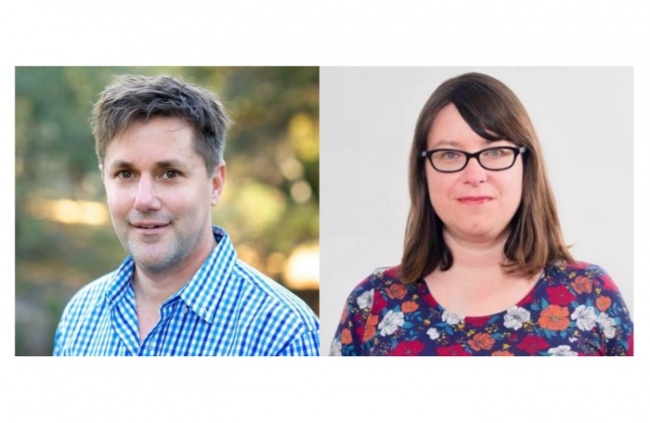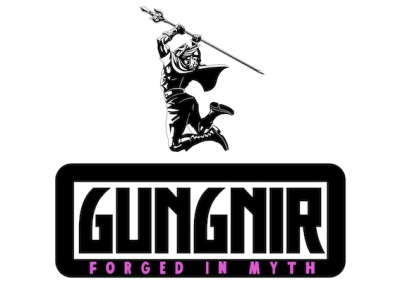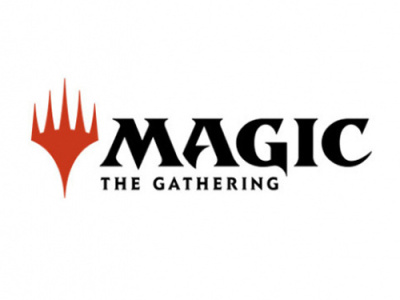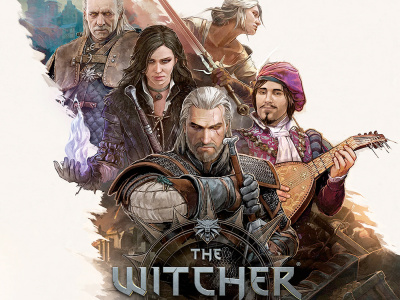We talked to IDW Chief Creative Officer Chris Ryall and Group Editor Sarah Gaydos about the kids comics and graphic novel market, IDW’s strategy, and got some insights into the company’s top kids releases for the rest of the year.
ICv2: What’s your broad assessment of the state of the comics and graphics novel market right now?
Chris Ryall: I think there are a couple of ways to look at it. You can look at the pure numbers of the market; for me, I always like to look at the diversity of material more than anything else.
Just the fact that there are so many different kinds of comics, so many different publishers, and so many different audiences being catered to (in a way that I feel like have never been as served as they are now) is very exciting to me.
The numbers are always what they are. You see things ebb and flow, as always in comics. As the Big Two go, so go everybody else. If they aren't necessarily capturing the audiences to the same degree as times past, that tends to hit everybody.
Sarah Gaydos: I'm especially excited to see the growth happening in the young adult and kids markets, simply because that's getting the next generation, many of which are female and non‑traditional comic buyers, on the lifelong path of being comic lovers, comic buyers, and hopefully comic creators as well.
What are you seeing in the kids and YA market? Maybe you could talk a little bit about the differences between the comic store and book channel.
Ryall: I just saw today that DC did some organizational reshuffling. Bobbie Chase is now going to focusing on launching a kids line, which is great.
I like to think that we, earlier than anybody else, really identified the fact that the younger readers were being underserved a decade ago, and through things like My Little Pony, the Disney comics, Powerpuff Girls, and so many other things that we've done, we've really tried to reach that audience. I think the Star Wars comic we're doing this fall will allow us to reach that younger reader on a broader scale, than we've ever done before. That's exciting to me.
It's exciting that now, when parents that have been lifelong comic fans go into comic shops, they can find a lot of different things that they can pick up for their kids, too. That's the key to this business. That's the key to the lifelong strength of this business, is finding new readers, getting them hooked, and giving everybody something to read.
From that perspective, I'm really happy about what's going on. There is always some disparity between what people buy in comic shops versus what goes on in the mass market. I doubt that the bulk of Raina Telgemeier's books are sold in comic book shops.
Again, I think the fact that there are books like that, material like that, that can reach the masses on such a grand scale only helps the entire market and the entire comic book medium.
Gaydos: Absolutely. If that's the kind of thing, the Raina Telgemeiers of the world, or Captain Underpants, or whatever, that gets people in the door, and expands them into the greater wide world of comics, including coming into comic book shops, that's really what matters to me. I think it's really important that IDW and the industry as a whole expand what kids comics and YA comics mean.
My own experience, which I think is similar to a lot of girls, is that you read comic content when you're younger (in my generation, it was Calvin and Hobbes), and then something happens, where you feel at some point when you're starting into your pre-teen years like there isn't any more content for you.
Basically, I dropped off from that point until back in high school, when I was able to learn about publishers like Slave Labor Graphics, and find out that there was in fact content for me that entire time. I just wasn't being exposed to it.
Now we're all doing a much better job of having something for everyone at different times of their lives, including books that are little bit older, aspirational YA. I think we also could push further into younger comics as well. Those are incredibly important areas.
You're a little different from some other publishers. I don't think you have a separate imprint for younger readers. How do you identify what age segment your publications are for, and how should retailers organize your output that way?
Ryall: We don't do any kind of a rating system or anything like that. We've always gone by the fact that Locke & Key seems to stand out as a very different and more mature book than something like the Ninja Turtles animated comic.
We offer guidance, I guess. We don't rate the books, and we don't mark them, other than maybe marking a book for mature readers. We don't do anything to really signify, "This is for all ages. This is for children."
Kind of like when we were reading comics as kids, comics were just comics. They were for everybody. Something like the Turtles animated comic, My Little Pony, the Disney comics, those appeal to multiple audiences and generations.
Marvel's old Star Comics moved things into the sidelines so much that nobody over a certain age would pick them up. We don't necessarily segment things to that degree.
We hope that just the way the artwork and the properties themselves are created that they're very clear which is which. Within the books that we deem as the all‑ages books, we make sure all of the ads are for like material.
We don't advertise something like Locke & Key inside a My Little Pony comic. The ads are very targeted to what we think that reader base is.
What age are your younger books written to?
Ryall: It’s funny, we thought that the My Little Pony comic would be hitting 10‑ to 12‑year‑old girls. Then you find out that there's an audience far older than that.
The books are (kind of like the shows themselves) peppered with cameos and little nods that older fans are going to pick up, but younger fans may not get. They're kind of written for kids and their parents.
You want it to be a thing that doesn't talk down to kids, by any means, but you also like it to be a thing that anybody older is going to get a good reading experience out of as well.
Gaydos: It's a totally fine line, because I think what we're also seeing is genres and big markers between the two of them breaking down a little bit. I think you see that in YA literature a whole bunch. Adults of all ages are still reading what is technically considered YA material.
I even enjoy Tiny Titans. It's a great book. That's a pretty young‑targeted book. At the same time, knowing that younger children are reading it, you have to keep that in mind in terms of the age appropriateness, the diversity sensitivity as well.
Very important to have your antenna way up on things like that, as well as make sure that there's representation there so that all children see themselves in the book. That's really important to me as well.
Ryall: I had a conversation with one of my editors recently; I was reading one of the scripts for an all‑ages comic. It did have some really big words in there. I remember as a kid, I probably got more of my more advanced vocabulary from Stan Lee than I ever did from school.
I never want to be in a position of dumbing a book down or removing big words that might not work for all kids. At the same time, you don't want to have a thing that feels too far over anybody's head, either.
Like Sarah says, it's a fine line, and not really one that's defined. It's case by case. You know it when you read it.
Let's drill down a little bit onto some specific titles. The Star Wars Adventures title was big news (see "IDW to Produce Star Wars Kids Comics"). Can you talk a little bit about how you're going to format that, and then what kind of stories you're going to include?
Ryall: Star Wars Adventures it's going to have (probably) 16‑page lead stories. The page count isn't necessarily firmly locked down, but it'll have feature‑length lead stories focusing on characters that are at the forefront of people's attention.
When the new movie comes out, the comics this fall will feature Rey in the lead story. Then it'll have shorter backup stories that can delve into characters that are lesser known, or maybe aren't the ones always getting prominence in the movies.
It can be some of the old fan favorites. If somebody loves the bounty hunter Bossk, he's maybe not popular enough to carry his own lead story, but he can certainly occupy a backup story. The plan is to do one‑ to two‑part stories that are high adventure and fun, keeping a real firm focus on fun, and not worrying too much about continuity.
We won't contradict the canon, but we basically just want people to read these and see a fun, high adventure story. Then the backups can be, like I say, a little bit more playful, and feature lesser‑known characters.
What's the format going to be?
Ryall: They'll be the same. They'll be just monthly 32‑page comic books.
We were thinking they were going to be digest or smaller format.
Ryall: They'll be collected into digest size, but we'll be releasing them as regular comic books as well. In fact, in September, when the book launches, we're going to release the first two issues biweekly.
First the comics, then collect them into a six‑by‑nine book?
Ryall: Yeah, then I'm sure we'll eventually also make thicker, regular size trade paperbacks. I think that six‑by‑nine, that smaller format, is something that younger readers are well used to reading and comfortable with.
It seems important to have a book that is very much in line with the kind of things that they like to read format‑wise, as well as content.
Then are you going to do anything special with distribution?
Ryall: We certainly always look to get our books into as many places as possible in the most unique way as possible. Everything from the fun packs that we've done in the mass market stores like Target and Walmart to other things. That's all in the planning stages right now.
We were thinking about the comics themselves. Are you going to put those on the periodical racks in Barnes & Noble?
Ryall: No, I think we'll use our same approach there. The trade paperbacks will be released pretty soon after the comics. There won't be a long wait for people to see them in the mass market.
Then let's talk about the two Disney titles that you just announced, DuckTales and Tangled. What's the interaction between the animated show continuity and the comic continuity, if any?
Gaydos: Very close. Especially, let's start with Tangled. One of the stories in the OGN that we're putting into the market in August is actually an adaptation. The other two are basically linked up with the show itself.
These are created within the Disney system, approved by the channel. They're in very close continuity. The art is gorgeous, and it matches quite well to the lush animation style that you'll see in the TV show. The same can be said for the DuckTales one.
We're not doing adaptations of the DuckTales episodes. These are stories set in the world, almost prequels to what you'll be seeing in the show. We're incredibly excited about both of them.
Beginning in June you’re doing two Jem titles, alternating; you have a comic every other week with continuing story. What's your thinking on accelerating the release schedule, or giving people content more frequently in a connected way?
Sarah: It's something that we've been experimenting with. We've had two Jem books up to this point over the last couple months with Jem, the ongoing series, and Misfits. We were playing around with the concept of the big sci‑fi summer blockbuster. That's how we came up with taking Jem back to its sci‑fi roots with a story set in an alternate world, where Synergy, which is obviously the technology that's central to Jem in the storyline, gets out into the world, which is something that's been a big fear of Jem and her sisters. What happens when something like that goes wrong? It was almost story‑based. Then we wanted to have a big, fun summer event book that people could jump on, pick up without having to read the other Jem and the Misfits books, and just enjoy it.
Between now and the end of the year, what are your other biggest kids releases that retailers that read our site should be focusing on?
Gaydos: The Pony movie prequel is definitely one that's high on my radar. That'll be out in June, the first of four issues.
Ryall: That leads directly into the movie and features the characters in the movie. That one's very nicely coordinated with that, which should be a big, big release for Hasbro and for us, too.
Gaydos: And Bobby, that editor, has been working incredibly closely with Hasbro and also the studio to make sure that all the content is really exciting, relevant, and I think even has some surprises that you won't see anywhere else, other than the movie.
Anything else you would like retailers to know about what's coming out from IDW between now and the end of the year in the kids space?
Gaydos: I just wanted to shout out one of the favorite books that I've been working on, and that's the Powerpuff Girls series. Part of what makes it so much fun are the writers, Haley Mancini and Jake Goldman.
They're actually writers on the show. They just absolutely nail the tone in the books. Every book makes me laugh out loud.
That's a perfect example of one of those books that's great for the parents and for the kids. Everybody can just enjoy it all at once.
Ryall: I was just going to mention the Teenage Mutant Ninja Turtles. Our Free Comic Book Day issue was a big Ninja Turtles comic. Then that leads into a five‑week event later this summer. We have plans to pair them up with some other characters once again by the end of the year. There's a lot of stuff planned in that world as well. I know the Turtles fan base spans across basically all age groups.
Gaydos: Definitely, and June sees the number one issue of TMNT Amazing Adventures ‑‑ Robotanimals!, which is very, very aimed at the younger Turtles fans, but also something that the adult Turtles fans are going to want to pick up.








